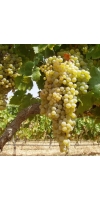Pedro Ximenez

Pedro Ximénez is a white wine grape variety that is also known by the terms “Pedro Gimenez” or “PX.” This variety is cultivated in South America and is said to have been introduced in the Canary Islands before being transported to Germany. It is said that the variety was introduced to Jerez by a soldier names Pedro Ximenez, who served in the Navy of King Charles the Fifth. The “Pedro Gimenez” variety is the most planted grape in Argentina and is used to craft fortified wines in the region of Jerez. This variety however, is different from the variety grown in Spain. The grape type is grown in Australia for Apera wines and can be blended to craft dessert wines. It is also used in Chile, Spain and is grown sparsely in California. The Pedro Ximénez variety features small round berries that are thin-skinned. Pedro Ximenez in Argentina produces fruit earlier in the year and contains leaves with three lobes. Wine made from the Pedro Ximenez grape typically pairs well with sweet desserts, such as rice pudding, caramel, an ice cream sundae, or Asian black sticky rice. The wines crafted typically use a process of drying out the grapes until they are almost raisin-like, and then taking the juice through other fermentation and aging processes. The taste of Pedro Ximenez features figs, dried fruits, or toffee.
Wine produced from grapes coming from the best vineyards from Sierra de Montilla and Moriles Alto (top quality area)
Aged in American Oak for 8 years
Color: Amber color with some topaz reflections.
An intense and elegant expression from the oxidative ageing process, with some dry fruits characters. The aromas are reminiscent of its ancestor - Fino. Velvety, warm, round and well-structured on the palate with almond flavors. A well-balanced wine.
Wonderful as an aperitif and to accompany soups and consommés. Extremely good where its distinctive taste adds unique character to a wide range of dishes. Try also with marinated meats and selfish as aperitif.
- back
Selected Options
Grape Types
Categories
Pricing
Countries
Regions
Grape Types
Wineries
Organic/Free Shipping
Elvio Cogno Cascina Nuova Barolo 2017
Born to satisfy the curiosity of consumers keen to have a more immediate understanding of Barolo, the wine is bright garnet red in color with orange tints. Pleasing and immediate, it offers scents of flowers and light, delicate spices. The mouth is agreeably rounded, juicy and fresh, with just the right balance between pleasantness and elegance. The aftertaste is very harmonious with a mineral, aromatic finish.
Review:
Attractive dried strawberry with cherry and tar on the nose. Full-bodied with powerful tannins that are dusty and intense. Very flavorful and long. Solid as a rock. Needs at least three or four years to soften and come together.
-James Suckling 95 Points
Argot Starstruck Cabernet Sauvignon is made from 90% Cabernet Sauvignon, 10% Merlot (15-25 years old)
An explosive nose of Cabernet—singular only to the Napa Valley—introduces the 2019 Starstruck with classically elegant red and black Cabernet fruits, enhanced by notes of smoked sage and rosemary. Red-fruits carry the mid-palate, dancing on a pillow of wonderfully sweet tannin and pie spice complexity. As the wine transitions from the mid, acid emerges lifting Starstruck's massive palate into a warming finish that continues to reveal dark fruits and intriguing spice accents. A gorgeous Cabernet that remains approachable, while its structure and earthy complexities keep bombast at bay.





